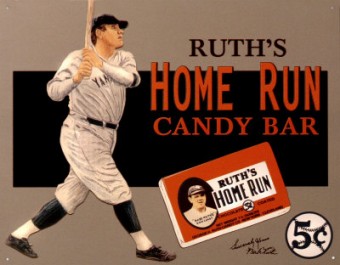Baby Ruth Candy Bars Actually Were Named After Babe Ruth
 Today I found out Baby Ruth candy bars really were named after Babe Ruth.
Today I found out Baby Ruth candy bars really were named after Babe Ruth.
The rumor that they were not was actually started by the company who made them originally, the Curtiss Candy Company founded by Otto Schnering. They claimed it was named after Ruth Cleveland, the daughter of President Grover Cleveland. Ruth Cleveland supposedly visited their plant and, while there, inspired the name for the candy bar.
There are a quite a few problems with the official line, but the main problem is that Ruth Cleveland died in 1904 at the age of 12 years old, some 17 years before the Baby Ruth candy bar was created and about 15 years before the Curtiss Candy Company was created. Further, Grover Cleveland hadn’t been President for 24 years and had been dead for 13 years when the candy bar was named, so there doesn’t seem to be a good reason they’d have randomly picked his daughter to name a candy bar after.
In addition to the above stated bits in the company’s official story, the Curtiss Candy Company also went on to discuss the fact that Babe Ruth wasn’t even famous in 1921 when the candy bar was named, so why would they name it after some random baseball player? Here’s another problem with the official story, Babe Ruth was incredibly famous by 1921.
In that year, Babe Ruth hit 59 home runs, had a .378 batting average, and a .512 on base percentage. The year before that, he had his breakout year with the Yankees hitting 54 home runs with a .376 batting average and a .533 on base percentage. From 1919-1921, he hit an astounding 142 home runs and was well on his way to revolutionizing the game of baseball. This all resulted in Babe Ruth’s fame skyrocketing from what it had been only a few years before serving primarily as a pitcher and pinch hitter for the Red Sox. Babe Ruth was a national celebrity in 1921.
Further, the original version of the “Baby Ruth” candy bar was actually called the “Kandy Kake” and was coincidentally renamed to “Baby Ruth” directly after Babe Ruth had become a national celebrity. The Curtiss Candy Company also tried to get Babe Ruth to endorse their product after its launch, which he refused to do. Not only that, but the Curtiss Candy Company was headquartered very close to Wrigley Field and, in 1932, they setup a giant lit advertising sign near the spot where Babe Ruth’s supposed “called shot” landed, advertising Baby Ruth candy bars, fully visible from Wrigley Field. This sign remained there for four years.
 Over and over again they attempted to associate their candy bar with Babe Ruth. The cover story told by the company was simply a way to get around having to pay Babe Ruth royalties for the use of his nickname and last name in their marketing efforts. The Curtiss Candy Company even had to use this story in actual legal proceedings when the manufacturer of the Babe Ruth Home Run Bar challenged the Baby Ruth name in court, claiming the Curtiss Candy Company were using the name without Babe Ruth’s permission, something the makers of the Babe Ruth Home Run Bar had managed to get from Ruth. The Curtiss Candy Company then successfully defended their candy bar’s name using the above “daughter of Grover Cleveland” story, which is full of inaccuracies and strains credibility.
Over and over again they attempted to associate their candy bar with Babe Ruth. The cover story told by the company was simply a way to get around having to pay Babe Ruth royalties for the use of his nickname and last name in their marketing efforts. The Curtiss Candy Company even had to use this story in actual legal proceedings when the manufacturer of the Babe Ruth Home Run Bar challenged the Baby Ruth name in court, claiming the Curtiss Candy Company were using the name without Babe Ruth’s permission, something the makers of the Babe Ruth Home Run Bar had managed to get from Ruth. The Curtiss Candy Company then successfully defended their candy bar’s name using the above “daughter of Grover Cleveland” story, which is full of inaccuracies and strains credibility.
If you liked this article, you might also enjoy our new popular podcast, The BrainFood Show (iTunes, Spotify, Google Play Music, Feed), as well as:
- The 17 Year Old Girl Who Struck Out Babe Ruth and Lou Gehrig Back to Back
- Babe Ruth – The Ladies’ Man
- A Lesson in Failure- The Rise of the Mars Candy Company
- A Little Money on the Side- The Interesting Origins of the Reese’s Peanut Butter Cup
- The Truth About Why Coke Tried to Switch to “New Coke”
Bonus Facts:
- Seventy four years after the Baby Ruth candy bar was named after Ruth, Nestle, who now owns the rights to the Baby Ruth candy bar, finally officially acquired the rights to use Ruth’s name and likeness in Baby Ruth marketing campaigns.
- Nestle has since played this up even more when in 2007 they claimed the Baby Ruth candy bar is “the official candy bar of major league baseball”.
- In 1923, Otto Schnering, the founder of the Curtiss Candy Company, hired a pilot to fly his plane over Pittsburgh and drop several thousand Baby Ruth candy bars over the city. Each candy bar was equipped with a parachute, to avoid injuring people.
| Share the Knowledge! |
|





She was Cleveland’s daughter, not granddaughter
I believe Baby Ruth’s were originally named after Grover Clevland’s daughter Ruth, who did die at age 12 from diphtheria. ….and then later used Babe Ruth to increase popularity and sales……. hence the name of the candy bar “Baby Ruth” and not “Babe Ruth”….just saying… …. ….I actually did a report in high school on presidents and Grover was one of them and found this out through my research.. … also you can Wikipedia it if you want…..
Didn’t even read the article above, did ya?
I did read your article, but there is information you (strategically?) refused to cite in your article that points to the original recipe being named after the president’s daughter.
I am related to Otto Schnering and it was not named after Babe Ruth. It was indeed after Ruth Cleveland.
If Ruth Cleveland died in 1904, 15 years before the Curtiss Candy Company was created, I find it kind of hard to believe that she ever visited their factory.
Baby Ruth is not Babe Ruth’s candy. However, Babe Ruth did have a candy; it was called Babe Ruth’s Home Run.
Talk about credibility! Your article’s credibility has to be in question when, not once, but TWICE refer to Wrigley Field as “Wrigley Stadium”! I suggest you do more homework the next time you write an article.
The fact that they had to defend the name in court is decisive. Clearly the Ruth Cleveland narrative is a cover story to avoid civil liability. Good article, despite the naysayers.
Thirty years ago I personally met Ruth Schnering – daughter of Otto Schnering. She personally told me as we sat at her kitchen table that the Baby Ruth candy bar was named after her.
OK for this, but does anyone know the history of the “Bambino” candy bar? I found an ad for it dated March 15, 1926. It was called “The Master Bar” and made by a company called Vogan.